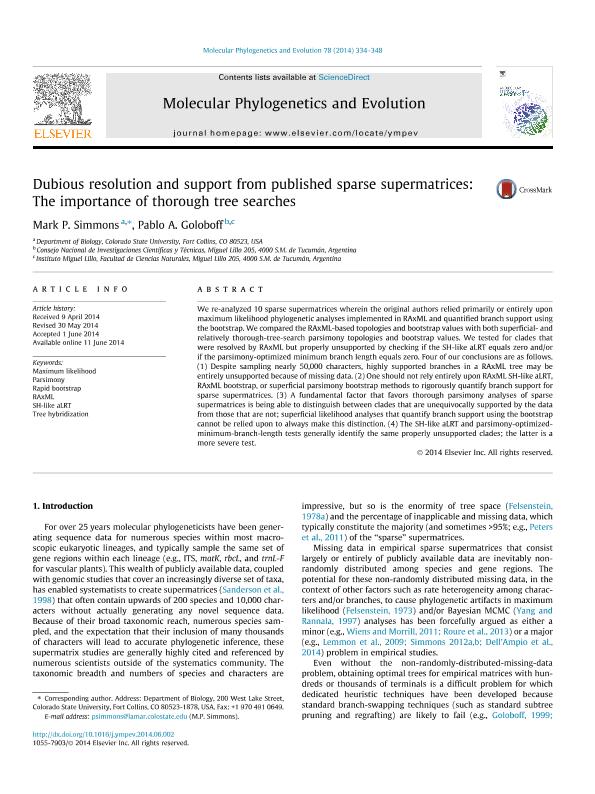Artículo
Dubious resolution and support from published sparse supermatrices: the importance of thorough tree searches
Fecha de publicación:
01/2014
Editorial:
Elsevier
Revista:
Molecular Phylogenetics And Evolution
ISSN:
1055-7903
Idioma:
Inglés
Tipo de recurso:
Artículo publicado
Clasificación temática:
Resumen
We re-analyzed 10 sparse supermatrices wherein the original authors relied primarily or entirely upon maximum likelihood phylogenetic analyses implemented in RAxML and quantified branch support using the bootstrap. We compared the RAxML-based topologies and bootstrap values with both superficial- and relatively thorough-tree-search parsimony topologies and bootstrap values. We tested for clades that were resolved by RAxML but properly unsupported by checking if the SH-like aLRT equals zero and/or if the parsimony-optimized minimum branch length equals zero. Four of our conclusions are as follows. (1) Despite sampling nearly 50,000 characters, highly supported branches in a RAxML tree may be entirely unsupported because of missing data. (2) One should not rely entirely upon RAxML SH-like aLRT, RAxML bootstrap, or superficial parsimony bootstrap methods to rigorously quantify branch support for sparse supermatrices. (3) A fundamental factor that favors thorough parsimony analyses of sparse supermatrices is being able to distinguish between clades that are unequivocally supported by the data from those that are not; superficial likelihood analyses that quantify branch support using the bootstrap cannot be relied upon to always make this distinction. (4) The SH-like aLRT and parsimony-optimized-minimum-branch-length tests generally identify the same properly unsupported clades; the latter is a more severe test.
Palabras clave:
Phylogeny
,
Bootstraping
,
Support
Archivos asociados
Licencia
Identificadores
Colecciones
Articulos(CCT - NOA SUR)
Articulos de CTRO.CIENTIFICO TECNOL.CONICET - NOA SUR
Articulos de CTRO.CIENTIFICO TECNOL.CONICET - NOA SUR
Citación
Simmons, Mark P.; Goloboff, Pablo Augusto; Dubious resolution and support from published sparse supermatrices: the importance of thorough tree searches; Elsevier; Molecular Phylogenetics And Evolution; 78; 1-2014; 334-348
Compartir
Altmétricas




